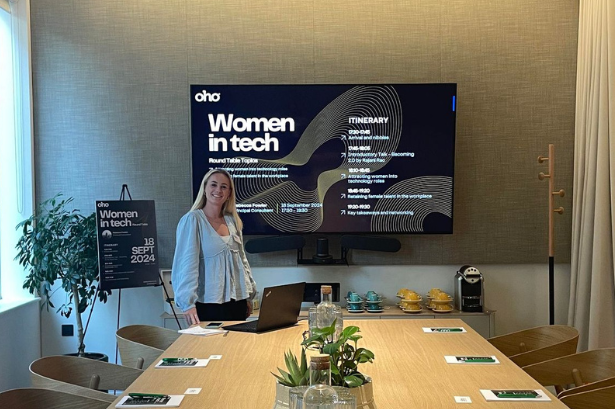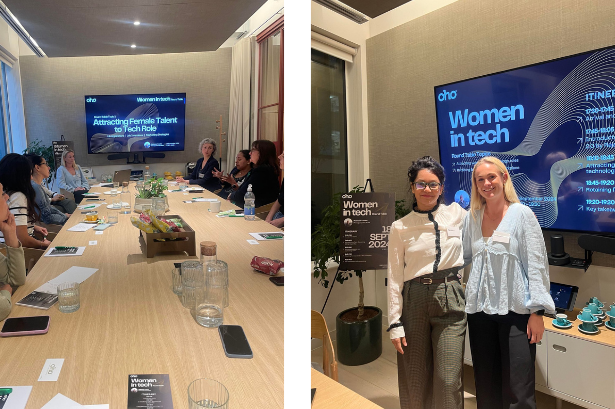
Top 10 Key Takeaways from Our Women in Tech Round Table
23 Sept, 20245 mins
Attracting and Retaining Female Talent
This month, the Oho Group hosted its first Women in Tech Round Table event, led by one of our Principal Consultants Rebecca Fowler. The event aimed to ignite discussions around attracting women to tech roles and retaining female talent in the industry. We were honoured to have a group of inspiring women leaders join us, including Rajani Rao, R&D Principal Technologist at Aveva and Director of the Women Coding Community, who delivered her empowering talk titled "Becoming 2.0," focusing on the four pillars of self-leadership.
Here’s a summary of our top 10 key takeaways from the event:
1. Job Applications:
Women often hesitate to apply for roles unless they meet all the listed qualifications, which can limit their career opportunities in comparison to male counterparts who are more likely to apply even if they don't fulfil every criteria. This disparity can be addressed by restructuring job descriptions to emphasise growth potential, transferable skills and a broader interpretation of qualifications, rather than focusing solely on a rigid set of requirements.
2. Bias in Hiring:
Unconscious gender bias influences how CVs are evaluated, with male candidates often perceived as more competent than female candidates with identical qualifications. To promote fairness in recruitment, it’s crucial to recognise and address these biases. Implementing blind recruitment techniques and providing training on unconscious bias can help mitigate the issue. Additionally, creating diverse hiring panels ensures varied perspectives in decision-making. By confronting these biases, organisations can foster a more inclusive work environment and build a diverse, innovative workforce.
3. Salary Transparency and Gender Pay Gap:
The discussion around salary transparency and the gender pay gap highlighted significant concerns. Many participants noted that salary ranges, while intended to provide clarity, often result in women receiving lower offers compared to men. This disparity stems in part from societal conditioning, where men are generally more assertive in salary negotiations, while women may hesitate to negotiate or advocate for higher pay, fearing negative perceptions or rejection. Without clear salary transparency and structured pay frameworks, this negotiation gap contributes to a widening gender pay gap. Addressing this issue requires implementing transparent salary bands, encouraging open discussions on compensation, and training managers to ensure fair and equal pay practices during the hiring process. It was noted that larger organisations did tend to have clearer bandings for promotions which help mitigate some of the issues related to salary transparency.
4. Networking:
Building strong female networks is essential for women navigating male-dominated fields like technology. Groups such as Women Coding Community and Society of Women Engineers exemplify how these networks offer career support, job opportunities, and internal referrals that help women advance professionally. These communities provide access to mentorship, educational resources and connections with industry leaders, creating spaces where women can exchange knowledge and gain visibility. By fostering collaboration and advocating for each other's career growth, thesenetworks help women overcome challenges like gender bias, negotiate better salaries, and access leadership roles, empowering them to thrive in tech industries.
5. Female Representation in Leadership:
There was a consensus that having women on interview panels can positively influence the hiring process, as it creates a more inclusive environment and helps reduce unconscious bias. However, the challenge lies in the lack of women in senior technical roles. While there are often more women in managerial or HR-related positions, the technical workforce, particularly at senior levels, remains male-dominated. This disparity limits the availability of women to serve on interview panels for technical roles. To address this, companies need to focus not only on hiring more women but also on developing and promoting them into senior technical positions, ensuring there’s a larger pool of female leaders who can shape recruitment and workplace culture.
6. Retention Challenges:
Women in technical roles often transition to management, sometimes driven by personal life demands such as family responsibilities. While this shift can be a natural career progression, it frequently results in a loss of technical expertise within teams. When women do move into these management roles, there should also be women moving into the junior and senior positions to keep the gender balance in technical roles.
Additionally, during conversations about maternity leave, many women highlighted the difficulties they faced when returning to work. Proposed solutions included flexible work arrangements, self-advocacy, and methods for catching up professionally while managing emotional adjustments. Similarly overcoming feelings of guilt and fatigue, negotiating flexible work terms and aligning career growth expectations were also seen as crucial for a smooth transition back into the workplace.
Creating a more inclusive environment through mentorship, career development programs and clear pathways for advancement can help retain women in technical roles and ensure their long-term contributions to the field.
7. Work-Life Balance:
Women, particularly those with children or other responsibilities, often face significant challenges balancing work and family obligations. These challenges can limit their career advancement, with the lack of flexibility in traditional work environments forcing many to either reduce their hours or step back from their careers altogether. This discussion highlighted the importance of flexible work environments, which can enable women to manage both personal and professional responsibilities more effectively.
The conversation also advocated for shared parental leave in fostering equality both at home and in the workplace. When men take a more active role in family care, it helps normalise caregiving as a shared duty, easing the pressure on women to juggle these responsibilities alone. Encouraging men to share parental leave not only supports better work-life balance but also breaks down gender stereotypes around caregiving and career expectations.
8. Supportive Management:
Supportive managers are essential for retaining female talent in tech by understanding personal life demands, offering flexible work arrangements and fostering inclusive environments. They acknowledge the challenges of balancing work and personal responsibilities, which builds trust and loyalty. Creating a culture of inclusion ensures women feel valued and heard, while actively supporting professional development and recognising achievements fosters motivation and career growth. Ultimately, these practices cultivate a diverse and dynamic workforce, essential for innovation in the tech industry.
9. Cultural Change and STEM Encouragement:
Changing the narrative around women in tech is essential for increasing their representation in STEM fields. Encouraging girls from a young age to explore STEM can spark interest and build confidence, while relatable female role models can inspire them to envision careers in these areas. Additionally, improving recruitment practices by broadening outreach, implementing blind recruitment processes and creating targeted internship programs for women can help eliminate biases and attract diverse talent.
10. Diversity Beyond Gender:
Diversity of thought, including neurodiversity and gender diversity, is crucial for enhancing decision-making and team performance in tech. When teams consist of individuals with varied backgrounds and perspectives, they are more likely to generate innovative solutions and tackle complex problems effectively. Neurodiverse individuals contribute unique insights, while gender-diverse teams bring a broader range of experiences that enhance collaboration. By fostering diverse and inclusive teams, organisations can cultivate creativity and critical thinking, leading to improved performance and greater competitive advantage in the tech industry.
These points highlight strategies for attracting, retaining, and supporting women in the tech workforce while addressing biases and promoting diversity.

We're planning to host more Round Table Events soon! If you're interested in joining, please register your interest here: https://ow.ly/z5Et50TqI3G
Or get in contact with Rebecca at rebeccaf@oho.co.uk


